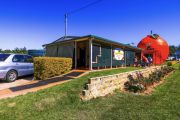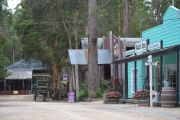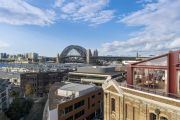
‘Back to normal’: Big builders’ profits pick up
Australia’s largest commercial builders have turned a corner on the period of soaring post-pandemic inflation, reporting a year with improved revenue and profit as cost growth eases and they complete loss-making projects struck in the COVID-19 era.
Queensland’s biggest builder J Hutchinson said total comprehensive earnings in the year to June more than doubled to $32.2 million even as revenue picked up less than half a per cent to $3.34 billion.

“We’re back to normal business,” Chairman Scott Hutchinson told The Australian Financial Review on Tuesday.
“It’s not too crazy. But everybody’s being careful about how much they take on.”
The caution is justified. Construction costs remain elevated – growth may have eased but costs themselves haven’t come down – and pressures on businesses remain. Insolvencies in the building sector were almost 29 per cent higher in the September quarter than they were a year earlier.
Former Rich Lister and real estate investor Andrew Roberts last week told The Financial Review the risks that outweighed the returns in construction cemented his decision to exit construction contracting – for a second time – after the collapse of his eponymous business Roberts Co earlier this year.
The head of the family-owned building company known universally as Hutchies said that while his profit margin nearly doubled – from 0.42 per cent to almost 1 per cent – that was boosted by rental income from the company’s commercial property holdings, rather than purely by better conditions for contractors.

“We’d love to get it to 2 [per cent] but that’s hopeful,” he said.
Sydney-based Richard Crookes Constructions turned profitable for the first year since 2022, chalking up a $14.2 million comprehensive profit – after a $28.2 million loss – on revenue that rose almost 5.5 per cent to $1.5 billion.
“There were still some loss-making projects still being delivered in FY25 but we’d taken up all the losses in FY24,” chief executive Jamie Crookes said.
“We’re in much better shape now. It’s that transition back to business as usual.”
The company that posted a 0.9 per cent net profit margin, higher than the 0.52 per cent margin it made in its last profitable year three years ago, was returning to “more historical margins,” Crookes said.
Current projects include the $780 million Sydney Biomedical Accelerator, a two-building research facility for University of Sydney, $450 million, 300-bed Integrated Mental Health Complex at Westmead Hospital and a $116 million upgrade to HMAS Harman, a naval base in Canberra.
“We’ve had a pretty good year of wins, but it’s been government-centric over the last 12 months,” Crookes said.
In contrast to Roberts, Crookes said clients remained prepared to share “a bit more” of the risk than they were pre-pandemic, but the outlook for new work was also slowing.
“The public sector is slowing a bit in their procurement and the private sector probably hasn’t picked up as fast we would have thought,” he said.
“There’s a lot in the pipeline but whether it converts into tenders or not… there’s still a lot of uncertainty in the pipeline.”
Hutchinson said after a more normal year he expected the Queensland construction market to boom again in 2027, as Olympics-related procurement picked up on top of the state’s existing health infrastructure spend.
“When the Olympics hit it’s going to be a different matter.”
In the medium term, Crookes said he didn’t expect a similar pick-up in NSW.
“We see the biggest risk is trades going to Queensland to work in that boom,” he said.
“Canberra is quite busy, but NSW will be flat.”
Construction is also battling its own obstacles.
Respondents to an industry survey by the Australian Constructors Association lobby group earlier this month said the biggest hurdles to greater productivity in construction were the industrial relations environment, followed by labour skills shortages across key trades, followed by compliance and regulatory burdens.
BuildCorp, another Sydney-based builder also reported a stronger year, with revenue jumping 23 per cent to $823.7 million and comprehensive profit leaping 30 per cent to $5.25 million.
Director Antony Sukkar was contacted for comment.
South of the Murray, Melbourne-based Kane Constructions recorded a 5.9 per cent increase in revenue to $1 billion, while comprehensive profit surged 58 per cent to $34.5 million.
Profit margin picked up to 3.5 per cent from 2.4 per cent a year earlier.











